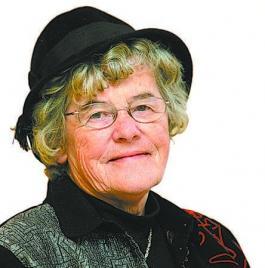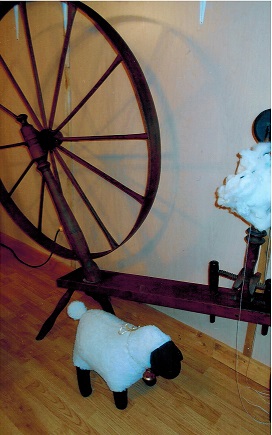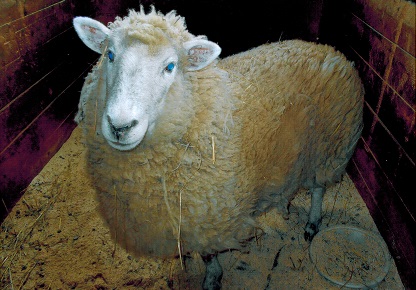
Ruby M. Cusack
Carders - Spinners - Weavers
I awoke early this Saturday morning to a bright sunny day.
The clock beside my bed showed seven o’clock which was mighty early for the old wringer washing machine to be thrashing away in the kitchen.
It seemed Mum had decided this would be a good drying day so she was washing the winter clothes and heavy quilts. The wind was always a concern as too much of a breeze could cause the clothesline to break.
Also, included in this job was the cleaning and oiling of the leather winter boots.
She inspected each piece of clothing, making note of the mittens and socks that needed to be darned or replaced.
At the day’s end, the winter apparel would be packed away to wait the return of another cold season. Everything would be in readiness for the Fall.
I was tired of the heavy winter clothes and looked forward to being allowed to wear summer clothes, especially my ankle socks.
Probably the sheep were also waiting to have their wool coats removed by the sheep shears.
Once the fleeces were removed, they were washed, carded, and spun into yarn.
Every season brought its task but always seemed to be a preparation for the next season to come.
As I was preparing this column, I realized I knew very little about the details of this important part of having the necessities of life in years gone by or how many a woman helped the family to survive financially by hiring out their services. In fact I didn’t even know that the term spinster came from many a single lady doing the spinning.
I contacted Judith Hill, who has a wealth of knowledge in hands on work of carding, spinning, dying, knitting and weaving. She even has her own studio. She took time to assume the role of teacher and told me many things about a generation, I knew little about. Also she put together a list of references for me, which I will share.
Judith Rygiel has written several books, such as “Thread in Her Hands - Cash in Her Pockets: Women and Domestic Textile Production in 19th-Century New Brunswick” which can be read online. One of the ladies I learned about was Martha J. Towle, who in 1871 was 46 years old, lived with her husband Horatio, and daughter Agnes on a 70-acre farm in St. David Parish in Charlotte County, where she produced 1,388 yards of cloth. According to the census of that year there were 100 weavers.
Also, Judith A. Rygiel’s Thesis, “The Homespun Economy” - Persistence of Handweaving in New Brunswick in the Nineteenth Century” is online.
An abundance of information can be found online in “The Women Weavers of Nineteenth-Century Queens County, New Brunswick” by Cynthia Wallace-Casey. For example, in 1849, Mary Morris Bradley published her memoirs and told of her early married life with David Morris. In 1793, when financial difficulties arrived, she became a weaver to keep the family going. Read about Betsey Starkey from Thorntown, with a cantankerous disposition and a need to drink tea, who took up using the loom for the MacDonald Family and wove blankets, kersey for working clothes, carpets with wide rainbow stripes running along the middle of the web, fine goods for women's petticoats and panties, and both blue and red pieces for men's shirts and underwear.
From W. Eugene Goodrich’s, Domestic Textile Production in Early New Brunswick, I found information on the flax growing and the work involved in pulling it from the ground, the drying and the turning process followed by combing out the seeds and much more before the spinning and weaving began. A field of flax with the blue blossoms was a beauty to behold.
A great deal of genealogical interest material can be found in these publications and are well worth reading.
Judith Hill enlightened me on how the food fed to sheep is reflected in the quality of the fleece.
The first spinning wheels were referred to as walking wheels. One type of a wheel was the Jenny Lind. Looms were used for weaving cloth and even carpets. Spinning one pound of carded wool would take nearly 16 hours. Wool cloth was pounded for a couple of different reasons.
Judy Hill’s Walking (Waulking) Wheel that is about 300 years old
was put together with hand made nails
and is still in working order. Photo - Courtesy of Judy Hill
Holly, a rescue lamb, who was not expected to live, found her forever home with Judy Hill.
Today she awaits the warm weather when her owner Judy Hill will have her sheared.
Having been fed an enriched diet, her fleece is of high quality,
which will be washed, carded, spun, and dyed.
The yarn will be used for knitting or weaving.
Holly considers herself the Manager of the Barn
and stamps her foot to make her position known.
Photo - Courtesy of Judy Hill
By the way, the Walking Spinning Wheel or Great Wheel was invented in the 14th Century and it was operated while standing. The spinners in Wales continued to use the Great Wheel until the 19th Century. The first record of a Spinning Wheel in Europe was in 1280. The Great Wheel is more than five feet in height.
The Treadle Wheel is powered by the spinner’s foot and the hands are left to control the wool.
The Spinning Wheel increased the productivity of yarn and thread making by more than 10%.
Doing a Full-Text Search by occupation on Daniel Johnson’s Vital Statistics from New Brunswick on the Provincial Archives of New Brunswick website can provide very interesting details on some residents of the province.
The Daily Telegraph of March 13, 1889 carried an article on Mrs. George Milbury of Wicklow, Carleton County, who has an old fashioned spinning wheel which she is positive is not less than 150 years old. The wheel descended to Mrs. Milbury from her mother, Mrs. Estabrooks of Burton, Sunbury County and before that belonged to Mrs. Turney of Burton and Mrs. Hatheway of Burton. The wheel has been in Mrs. Milbury's possession for the last 40 years during which time it has been in use and is now in good working order.
On December 13, 1893, the Union Advocate mentions Robert Loggie, late of Black Brook, Northumberland County died at the home of his sister, Mrs. Manderson. His spinning wheels were famed for their finish and workmanship.
The November 22, 1887 issue of The Times gives interesting facts on the woollen mill of Messrs. Humphrey & Snow, which was about a mile outside of Moncton at a station and post office now known as Humphrey's. A carding mill was started here by John Humphrey, uncle of the present member of the firm in 1832. The carding machinery was made in the province by a Scotch machinist who had emigrated here in 1815 and who married Mr. Humphrey's sister. He set up this and several other mills in the province. There had been a mill at Sackville before this and one or two carding mills existed in New Brunswick between the years 1815 and 1820. When this mill was started, people paid six pence a pound to get their wool carded and brought it in from points 50 miles away. It was brought to the mill in big sacks on horseback and the farmers spun it into rough homespun. The cards were then made into two separate machines and had of course to be fed twice and some machines had only two stripers. George Pickett started a woollen mill and did weaving about 1830 at Kingston, Kings County and the grandfather of the present Mr. Snow worked in this mill.
Andrew Sherwod Beyea's History of French Village mentions, William Snow was born in Cherryfield, Maine. He established on his farm the first carding and woolen mill in Kings County. The locals of today say it was on Snow’s Brook in Smithtown.
According to The Daily Telegraph of March 9, 1894, Mrs. Charlotte Flagg, 94 years of age, was buried at Castalia, Grand Manan, Sunday last. Until a few months ago she was in full possession of all her faculties and insisted on doing her own spinning, carding and housework. She was the oldest person on the Island
As one delves into the long gone industry of carding, spinning and weaving services, it becomes evident, it was not only providing for the family, but often a means of supporting or supplementing the family's income.
|
New and Used Genealogical and Historical books of New Brunswick for sale. |
Back to Home of rubycusack dot com

